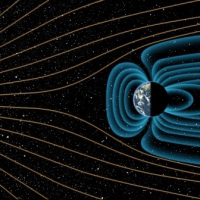Rocks Contain the Earliest Proof of Earth's Magnetic Field
Rocks Contain the Earliest Proof of Earth's Magnetic
Field
The earliest indication of Earth's
magnetic field was found by Oxford University and MIT geologists in rocks
from Greenland's Isua Supracrustal Belt that date back 3.7 billion years. This
discovery raises the possibility that Earth's circumstances were habitable
sooner than previously believed, with a stable magnetic shield playing a key
role. The planet's magnetic field keeps the atmosphere alive, shields it from
dangerous solar radiation and cosmic rays, and permits liquid water—which is
necessary for life—to exist. The strength of the old field was discovered by
researchers by examining the magnetic characteristics and mineral orientation
of iron-oxide, extending the known existence of Earth's magnetic field by 200 million
years.
The
Earth's Magnetic Field Is Importan
The planet is largely shielded from dangerous solar radiation and cosmic rays
by the Earth's magnetic field. In addition, it facilitates the existence of
liquid water, which is necessary for life as we know it, and aids in
maintaining a stable environment. Comprehending the Earth's magnetic field's
strength and history offers valuable understanding of the planet's evolution
and its capacity to harbor life.
Analyze
Techniques
Rock samples were gathered by the researchers from Greenland's Isua
Supracrustal Belt, an area well-known for its prehistoric rock formations. The
researchers discovered the existence of a magnetic field that dates back 3.7
billion years by examining the magnetic characteristics of these rocks,
including the orientation of iron-oxide particles. The lab demagnetized the
samples, and the strength of the old magnetic field was determined by comparing
them to known field strengths.
Effects on Life and
Habitability
The magnetic field found to be 3.7 billion years old raises the possibility
that Earth's circumstances were habitable earlier than previously believed.
It's possible that the stable magnetic shield was essential in establishing a
favorable environment for the emergence of life. This study suggests that a
high magnetic field may be essential for supporting complex life forms, which
has ramifications for the hunt for life on distant worlds.
Prospective
Studies and Importance
The
development of the Earth's magnetic field and its influence on planetary
habitability can now be studied in new ways thanks to this research. Gaining
knowledge about the evolution of the magnetic field over billions of years can
be extremely beneficial in determining the long-term sustainability and
resilience of the planet. Additional hints on the early history of Earth and
the advent of life may be found by further investigating old rocks and the
magnetic traces they leave behind.
